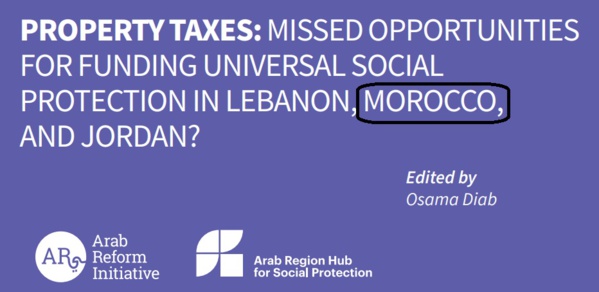Introduction
The West Asia-North Africa (WANA) region (also known as the Middle East and North Africa) has poor tax collection rates. At first glance, one might attribute this to oil-producing countries known for low tax rates. However, even when excluding these countries, the tax rate in oil-importing countries remains around 18%, which is below both the global average and the averages of comparable countries and regions. The gap between the region and the world increases when only direct taxes are considered because indirect taxes account for a higher share of the region’s total tax revenue.1 Among oil-importing countries, the situation is better in the Maghreb than in the Mashreq, where the tax-to-GDP ratio is approximately 26%. In contrast, the Mashreq has a ratio of 14.5%. In the oil-rich Gulf Cooperation Council (GCC) countries, this ratio drops to 1.48%. Additionally, Maghreb countries benefit from a lower proportion of indirect taxes on goods and services, accounting for about 45% of their tax revenue, compared to the Mashreq countries, where indirect taxes constitute approximately 55% (see table below).2
| Tax revenues as a percentage of GDP | Indirect taxes on goods and services as a percentage of total tax revenue | |
| Oil-importing Mashreq countries | 14.5% | 54.5% |
| Oil-importing Maghreb countries | 26.0% | 44.87% |
| Oil-exporting countries | 1.5% | 22.48% |
| Total region | 10.9% | 39.23% |
| Source: Claire Burkhardt and Mehmet Tosun, “Taxation in MENA: Composition, Trends and Policy Options”, The Economic Research Forum, 2020 | ||
Despite significant variations among the three groups of countries, a common factor is the almost complete absence of property taxes in their tax systems.3 This study focuses on the region's net oil-importing countries and explores the potential of property taxation to improve the deteriorating welfare and protection situation in these countries. We examine two models from the Levant – Lebanon and Jordan – and one from the Maghreb – Morocco.4 Lebanon is characterized by a sharp decline in tax collection due to political and economic crises,5 while Jordan maintains relatively stable tax collection at 16-18% of GDP. Morocco, on the other hand, has one of the highest tax collections in the region, exceeding 20% of its GDP.6
This study explores the opportunities provided by real estate taxes in financing comprehensive social protection programs. We focus on real estate taxes for several reasons. First, as mentioned earlier, the current yield from all types of real estate taxes in the region is very low, indicating significant potential for increased revenue.
Second, taxes on immovable assets are relatively easy to implement in the region due to low administrative efficiency, limited resources, and widespread economic fragility. When imposing a new tax, authorities typically face three main challenges: administrative, economic, and political. Administrative challenges involve the availability of expertise, as well as necessary human and technological resources to implement the tax effectively. It is also crucial to ensure cost efficiency so that administrative expenses do not exceed or come close to the size of the tax collected. Real estate taxes are less susceptible to evasion compared to income and profit taxes, as real estate cannot be hidden. This is important in countries where tax authorities lack the resources and technical know-how that large multinational corporations use to minimize their tax liabilities. Additionally, real estate taxes can be implemented immediately, as they do not require extensive administrative preparation, except for improving the quality of real estate databases.
There are also economic challenges associated with imposing a new tax. This raises key questions including: Will it affect consumption and public demand as consumption taxes do? Will it increase or decrease wage and wealth disparities? Could it lead to capital flight? Will it give special incentives to some sectors over others? From an economic perspective, real estate taxes are considered fair tax because they do not increase the tax burden on lower- and middle-income groups, who are already heavily taxed and burdened through indirect and wage taxes. Additionally, real estate taxes are not viewed as a deterrent to job-creating investment. Among taxes targeting the rich, these taxes have the least negative spillover effects – both actual and perceived – on lower-income groups.
Moreover, real estate-related taxes help regulate the real estate market and limit rampant speculation. This is particularly beneficial in countries suffering from inflation and lacking a strong productive sector to attract capital. By taxing real estate, surplus capital is prevented from being absorbed into speculative real estate ventures in a value-preserving manner. Instead, such taxes can direct capital toward productive, job-creating activities, fostering economic growth and stability.
When it comes to political challenges, resistance from certain social groups to paying a new tax is common, and examples of this are endless. We saw in Lebanon how the imposition of a popular tax on WhatsApp in 2019 was the spark that ignited the 17 October Revolution and served as a Trojan horse that carried all the accumulated economic, political, and social grievances in Lebanon. Regarding taxation of the economic elite, Egypt has been postponing a capital gains tax on stock trading due to objections from stock market investors and the stock index plummeting every time talk of imposing it surfaced.7 Although real estate taxes face political challenges like any other tax, this volume argues that they are among the easiest to administer and have the least negative economic impact.
This volume argues that such taxes have positive economic effects for the vast majority of citizens, such as lowering rents and real estate prices and directing capital to productive, job-creating activities. Therefore, any delay in enacting real estate taxes in the region can only be attributed to the significant influence of those subject to the tax and their unwillingness to bear its cost, despite its considerable social benefits. Beyond the tax gap, MENA countries also face significant social protection gaps in housing, health, and social insurance, particularly for unorganized labor, which is highly prevalent in our region.
This volume attempts to demonstrate that there is a significant opportunity to finance comprehensive social protection programs through the taxation of real estate wealth. It includes three case studies that explore how property taxes can finance comprehensive housing programs in Lebanon, fund a large part of a comprehensive social protection scheme in Morocco, and cover half the value of voluntary insurance contributions for unorganized and uninsured workers in Jordan. In her paper, Studio Public Works urban researcher Christina Abou Rouphaël demonstrates that there is ample room in Lebanon to increase property tax revenues and regulate the chaotic real estate market, where real estate speculation at the expense of the right to housing is so rampant that the vacancy rate is around 23%. The proposed tax has a dual purpose: first, to regulate the real estate market to provide affordable housing to as many people as possible, and to collect taxes to be used to ensure the universal right to housing enshrined in the International Covenant on Economic, Social and Political Rights (ICESCR). Abou Rouphaël shows how just one of several real estate-related taxes could generate $100 million a year if applied to vacant medium and luxury housing. This amount is sufficient to provide rental subsidies for 50,000 families annually, offer seed capital to establish 25 housing cooperatives each year benefiting 350 families and build 1,000 homes for 1,000 families annually on state-owned land. She also discusses other types of taxes, such as a tax on real estate profits, which could generate a billion dollars annually. If implemented, this could extend the right to housing to all poor families in Lebanon, achieving the desired and legally stipulated comprehensiveness. This does not include the indirect impact of such measures, which could reduce rents and real estate prices, as Abou Rouphaël explains in her paper. This type of protection is pivotal, and perhaps the most important, in the Lebanese context, where the housing crisis and prices have worsened to the point that average rents exceeded average wages – even though housing costs should ideally be around 30% of average wages.
In his paper on Morocco, economics and development professor Abdelhak Kamal explains how targeting the highest-value properties in Morocco could provide one-sixth of the total annual cost of all planned social protection programs in Morocco, or one-quarter of the value of solidarity funding from non-contributors. Drawing inspiration from the French experience – which went beyond labor contributions to fund social security programs by using property taxes as a sustainable and stable source of funding – he argues that such a tax would reduce asset inequality and speculation without affecting labor incomes or labor-intensive productive investments. This is because it would not increase insurance costs for employers and indirectly penalize them for creating jobs. Finally, the paper shows that targeting major wealth through real estate, as an indirect proxy indicator of wealth, is an effective solution in countries in our region that lack reliable income and wealth data.
Returning to the Levant, Ahmed Awad, Director of the Phoenix Center for Economic and Information Studies, urges us to focus on taxing empty apartments, which amount to more than 18% of the total housing units in Jordan – representing more than 400,000 housing units. This percentage rises to 23% in the capital, Amman. In that case, imposing a graduated tax averaging only 50 dinars per month on less than half of the vacant housing units could generate 116 million dinars annually, enough to cover half the cost of social security contributions for more than 300,000 unorganized laborers. Awad also reminds us that 59% of workers in Jordan are not covered by any social protection system, making such a tax an urgent social necessity whose cost pales in comparison to its critical social importance.
In short, property taxes appear to be an effective solution to many social protection issues in our region. However, given the severe shortfall in funding for social protection programs and social spending, the failure to explore these opportunities so far raises doubts about the willingness to sacrifice the role of the real estate sector as a means of absorbing surplus capital, as a store of value in the face of high inflation for the higher income classes, and as a tool to achieve economic growth amid the decline of industry and agriculture — rather than to provide adequate and affordable housing and secure the universal legal right to housing for the entire population.
Endnotes
| ↑1 | Claire Burkhardt and Mehmet Tosun, “Taxation in MENA: Composition, Trends and Policy Options”, The Economic Research Forum, 2020, available at: https://theforum.erf.org.eg/2020/11/24/taxation-mena-composition-trends-policy-options/ |
|---|---|
| ↑2 | Claire Burkhardt and Mehmet Tosun, “Taxation in MENA”. |
| ↑3 | Amr Adly, “Property Taxes Are the Arab World's Low-Hanging Fruit”, Bloomberg, 2020, available at: https://finance.yahoo.com/news/property-taxes-arab-world-low-085224911.html |
| ↑4 | Amr Adly, “Property Taxes Are the Arab World's Low-Hanging Fruit”, Bloomberg, 2020, available at: https://finance.yahoo.com/news/property-taxes-arab-world-low-085224911.html |
| ↑5 | World Bank Data, Tax Revenue (% of GDP) - Lebanon, World Bank, 2024, available here |
| ↑6 | World Bank Data Site, “Tax Revenue (% of GDP) - Jordan, Lebanon, Morocco”, undated, available here |
| ↑7 | [6]]url:https://www.arab-reform.net/publication/property-taxes-missed-opportunities-for-funding-universal-social-protection-in-lebanon-morocco-and-jordan/#_ftnref6 Mada Masr, “For the tenth year. Government postpones stock market profits tax”, 2 May 2024, available here |
The views represented in this paper are those of the author(s) and do not necessarily reflect the views of the Arab Reform Initiative, its staff, or its board.



 الدكتوراه في قانون العقود والعقار ـ إشراف الدكتور إدريس الفاخوري
الدكتوراه في قانون العقود والعقار ـ إشراف الدكتور إدريس الفاخوري 













 Property Taxes: Missed Opportunities for Funding Universal Social Protection in Lebanon, Morocco, and Jordan?
Property Taxes: Missed Opportunities for Funding Universal Social Protection in Lebanon, Morocco, and Jordan?













